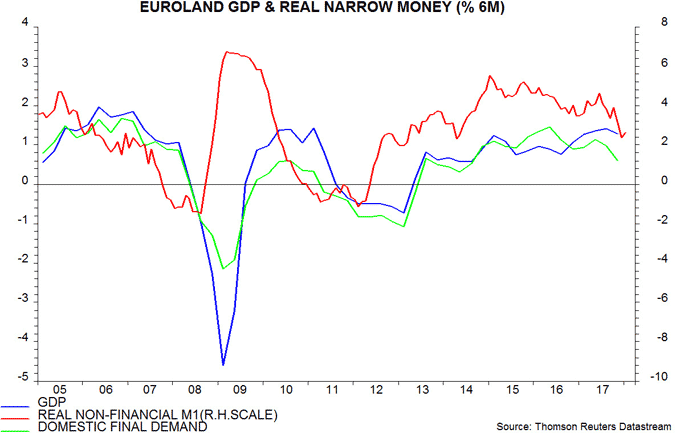Euroland domestic demand unimpressive, trade boost peaking?
Euroland domestic demand slowed during the second half of 2017, with strong GDP expansion sustained by a rise in net exports, reflecting global economic buoyancy. Monetary trends suggest that domestic demand will remain subdued in 2018, while global cooling and euro appreciation may drag on trade performance. The consensus assessment of economic prospects may be overly positive.
Revised figures released today confirm an earlier estimate that GDP grew by 1.3%, or 2.6% at an annualised rate, during the second half of 2017 (i.e. between the second and fourth quarters). The “news” was in the expenditure breakdown: domestic final demand rose by only 0.6%, while a rise in net exports contributed 0.9 of a percentage point to GDP expansion. Total domestic demand grew by just 0.4% as inventory accumulation was cut back between the second and fourth quarters.
Two-quarter growth of domestic final demand peaked as long ago as the second quarter of 2016, with the moderation since then consistent with a decline in six-month real narrow money growth from a peak in January 2015 – see chart. Monetary trends recovered modestly in the first half of 2017 before turning down again late in the year. Domestic final demand growth may stabilise or rebound in early 2018 but prospects for the second half appear lacklustre.

GDP growth has probably remained solid in early 2018, partly reflecting a rebound in inventory accumulation, but global cooling, the stronger euro, softer domestic final demand and a fading of the inventories boost may combine to produce a significant slowdown during the second half of the year.
The recent dependence of GDP growth on net exports may heighten ECB concerns about euro appreciation but any attempt by President Draghi to “talk down” the currency at this week’s press conference would risk enflaming US protectionist sentiment.

Reader Comments